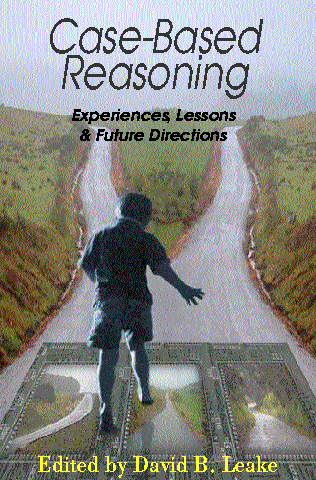
CASE-BASED REASONING: EXPERIENCES, LESSONS, AND FUTURE
DIRECTIONS
1996, second printing 2000
AAAI Press/MIT Press.
420 pp., $40, ISBN 0-262-62110-X.
This book can be ordered online from the MIT Press.
The first chapter, CBR in
Context: The Present and Future, an overview with extensive
references, is available on-line.
Preface:
Case-based reasoning (CBR) is now a mature subfield of artificial
intelligence. The fundamental principles of case-based reasoning have
been established, and numerous applications have demonstrated its role
as a useful technology. Recent progress has also revealed new
opportunities and challenges for the field. This book presents
experiences in CBR that illustrate the state of the art, the lessons
learned from those experiences, and directions for the future.
True to the spirit of CBR, this book examines the field in a
primarily case-based way. Its chapters provide concrete examples of
how key issues---including indexing and retrieval, case adaptation,
evaluation, and application of CBR methods---are being addressed in
the context of a range of tasks and domains. These issue-oriented
case studies of experiences with particular projects provide a view of
the principles of CBR, what CBR can do, how to attack problems with
case-based reasoning, and how new challenges are being addressed. The
case studies are supplemented with commentaries from leaders in the
field providing individual perspectives on the state of CBR and its
future impact.
This book provides experienced CBR practitioners with a reference to
recent progress in case-based reasoning research and applications. It
also provides an introduction to CBR methods and the state of the art
for students, AI researchers in other areas, and developers starting
to build case-based reasoning systems. It presents experts and
non-experts alike with visions of the most promising directions for
new progress and for the roles of the next generation of CBR systems.
Contents:
- CBR
in Context: The Present and Future
David B. Leake.
- A Tutorial Introduction to Case-Based Reasoning
Janet L. Kolodner and David B. Leake
- Indexing Evaluations of Buildings to Aid Conceptual Design
Anna L. Griffith and Eric A. Domeshek
- Towards More Creative Case-Based Design Systems
Linda M. Wills and Janet L. Kolodner
- Retrieving Stories for Case-Based Teaching
Robin Burke and Alex Kass
- Using Heuristic Search to Retrieve Cases that Support Arguments
Edwina L. Rissland, David B. Skalak, and M. Timur Friedman
- A Case-Based Approach to Knowledge Navigation
Kristian J. Hammond, Robin Burke and Kathryn Schmitt
- Flexible Strategy Learning Using Analogical Replay of Problem Solving
Episodes
Manuela M. Veloso
- Design a la Deja Vu: Reducing the Adaptation Overhead
Barry Smyth and Mark T. Keane
- Multi-plan Retrieval and Adaptation in an Experience-Based Agent
Ashwin Ram and Anthony G.Francis, Jr.
- Learning to Improve Case Adaptation by Introspective Reasoning and
CBR
David B. Leake, Andrew Kinley, and David Wilson
- Systematic Evaluation of Design Decisions in Case-Based Reasoning
Systems
Juan Carlos Santamaria and Ashwin Ram
- The Experience Sharing Architecture: A Case Study in Corporate-
Wide Case-Based Software Quality Control
Hiroaki Kitano and Hideo Shimazu
- Case-Based Reasoning: Expectations and Results
William Mark, Evangelos Simoudis, and David Hinkle
- Goal-Based Scenarios: Case-Based Reasoning Meets Learning by Doing
Roger C. Schank
- Making the Implicit Explicit: Clarifying the Principles of Case-Based
Reasoning
Janet L. Kolodner
- What next? The Future of CBR in Postmodern AI
Christopher K. Riesbeck
Other home pages for the book
Additional
CBR publications by David Leake are available on the web.
Erratum
In some copies, Figure
12 is missing from Kitano, H. and Shimazu, H, ``The Experience
Sharing Architecture: A Case Study in Corporate- Wide Case-Based
Software Quality Control.''
